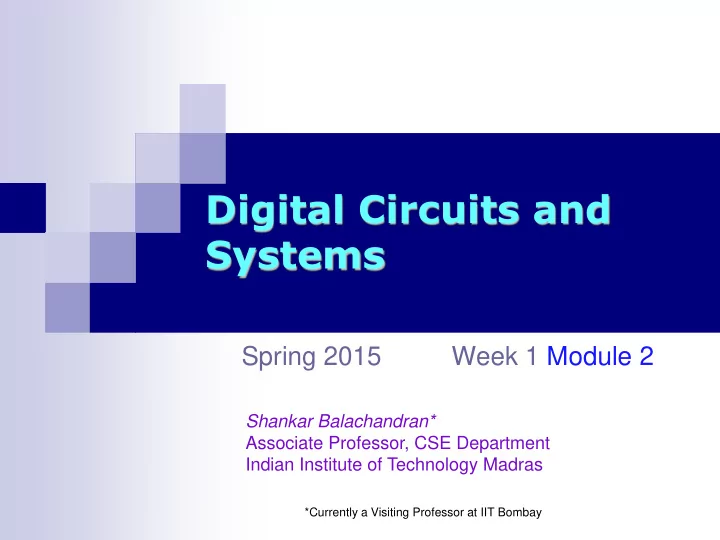

Digital Circuits and Systems Spring 2015 Week 1 Module 2 Shankar Balachandran* Associate Professor, CSE Department Indian Institute of Technology Madras *Currently a Visiting Professor at IIT Bombay
Binary Switch x = 0 x = 1 (a) Two states of a switch S x (b) Symbol for a switch
A Light Controlled by a Switch S Battery Light x Simple connection to a battery
Two Basic Functions S S (a) The logical AND function Power Light x 1 x 2 supply (series connection) S x 1 (b) The logical Power OR function Light supply S (parallel connection) x 2
A Series Parallel Circuit S x 1 S Power Light supply S x 3 x 2
An Inverting Circuit R Power supply Light S x
Truth Table
Truth Table of 3-Input AND and OR Operations
Truth Table of 3-Input AND and OR Operations
Symbols AND Dot ( ) v Imagine it to be like multiplication Example x y Called “x and y” OR Plus ( + ) Imagine it to be like addition Example x + y Called “x or y ” Introduction 13
NOT Operation Symbol Closing single quote ’ Also overline and ! symbol Example: x’, x, !x Calling x complement “not of x” Simpler: “x bar” Introduction 14
x 1 x 2 x 2 x 1 x 1 x x 1 x n 2 x 2 x n (a) AND gates Symbols x 1 x 2 x 1 x x 1 x + x 1 x + + + 2 2 n x 2 x n (b) OR gates x x (c) NOT gate Introduction 15
Boolean Algebra Named after George Boole Axioms 0 · 0 = 0 0 + 0 = 0 0’ = 1 Duality 1 · 1 = 1 1 + 1 = 1 1’ = 0 0 + 1 = 1 + 0 = 1 0 · 1 = 1 · 0 = 0 Introduction 16
Single Variable Theorems x · 0 = 0 x + 1 = 1 x · 1 = x x + 0 = x x · x = x x + x = x x + !x = 1 x · !x = 0 x · x · x · … x = x !!x = x Introduction 17
Two Variable Theorems x · y = y · x x + y = y + x Both are commutative Introduction 18
Three Variable Theorems Associative Laws x · (y · z) = (x · y) · z x + (y + z) = (x + y) + z Distributive Law x · (y + z) = (x · y) + (x · z) x + (y · z) = (x + y) · (x + z) More as we go Introduction 19
End of Week 1: Module 2 Thank You Introduction 20
Recommend
More recommend